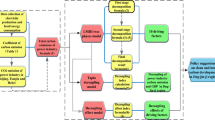Abstract
This study applied the Logarithmic Mean Divisia Index (LMDI) model to analyze changes in carbon dioxide emissions by Chinese power industry from 2003 to 2017. Besides, the Tapio decoupling analysis model is applied to explore the decoupling states between power industry carbon dioxide emissions and the corresponding influence factors. Several conclusions were obtained: (1) the power industry carbon dioxide emissions only displayed a slight downward trend during 2011–2012, 2013–2014, and 2014–2015; (2) the factors promoting the growth in power industry carbon dioxide emissions are energy consumption structure effect and total power generation effect. Power generation structural effect and fossil energy conversion efficiency effect inhibit the power industry carbon dioxide emissions from increasing, but they were far from offsetting the positive contribution value brought by total power generation effect; (3) changes in carbon dioxide emissions by the power industry were not sensitive to the change of fossil energy conversion efficiency and power production structure but were sensitive to the change of total power generation; (4) the contributions of technical effect were higher than those of structural effect on the decoupling index between impact factors and power industry carbon dioxide emissions.

Similar content being viewed by others
References
Ang BW (2004) Decomposition analysis for policymaking in energy: which is the preferred method? Energy Policy 32(9):1131–1139
Ang BW (2015) LMDI decomposition approach: a guide for implementation. Energy Policy 86:233–238
Ang BW, Xu XY, Su B (2015) Multi-country comparisons of energy performance: the index decomposition analysis approach. Energy Econ 47:68–76
Bithas K, Kalimeris P (2018) Unmasking decoupling: redefining the resource intensity of the economy. Sci Total Environ 619–620:338–351
Chen G, Hou F, Chang K (2018a) Regional decomposition analysis of electric carbon productivity from the perspective of production and consumption in China. Environ Sci Pollut Res 25:1508–1518
Chen G, Hou F, Chang K, Zhai Y, du Y (2018b) Driving factors of electric carbon productivity change based on regional and sectoral dimensions in China. J Clean Prod 205:477–487
Chen J, Wang P, Cui L, Huang S, Song M (2018c) Decomposition and decoupling analysis of CO2 emissions in OECD. Appl Energy 231:937–950
China National Bureau of Statistics (2018) http://data.stats.gov.cn/easyquery.htm?cn=C01
China’s National Bureau of Statistics (2004-2018) China Energy Statistical Yearbook. China Statistics Press, Beijing
Fan W, Meng M et al (2020) Decoupling elasticity and driving factors of energy consumption and economic development in the Qinghai-Tibet Plateau. Sustainability 12:1–22
Goh T, Ang BW, Xu XY (2018) Quantifying drivers of CO2 emissions from electricity generation–current practices and future extensions. Appl Energy 231:1191–1204
Intergovernmental Panel on Climate Change (2006) The guidelines for national greenhouse gas inventories. Institute for Global Environmental Strategies. IGES, Hayama
Kaya Y (1989) Impact of carbon dioxide emission on GNP growth: interpretation of proposed scenarios. Presentation to the energy and industry subgroup, response strategies working group of Intergovernmental Panel on Climate Change (IPCC), Paris
Li H, Zhao Y, Qiao X, Liu Y, Cao Y, Li Y, Wang S, Zhang Z, Zhang Y, Weng J (2017) Identifying the driving forces of national and regional CO2 emissions in China: Based on temporal and spatial decomposition analysis models. Energy Econ 68:522–538
Malla S (2009) CO2 emissions from electricity generation in seven Asia-Pacific and North American countries: a decomposition analysis. Energy Policy 37(1):1–9
Pan W, Tu H et al (2020) Driving forces of China’s multisector CO2 emissions: a Log-Mean Divisia Index decomposition. Environ Sci Pollut Res 27:23550–23564
Quan C, Cheng X, Yu S, Ye X (2020) Analysis on the influencing factors of carbon emission in China’s logistics industry based on LMDI method. Sci Total Environ 734:138473
Song H, Huang B, Yuan Z (2019) The energy saving mechanism of China’s industrial sectors based on LMDI Approach. Soft Sci 33(07):106–110
Tapio P (2005) Towards a theory of decoupling: degrees of decoupling in the EU and the case of road traffic in Finland between 1970 and 2001. Transp Policy 12(2):137–151
Wu Y, Tam VWY, Shuai C, Shen L, Zhang Y, Liao S (2019) Decoupling China’s economic growth from carbon emissions: empirical studies from 30 Chinese provinces (2001-2015). Sci Total Environ 656:576–588
Xie P, Gao S, Sun F (2019) An analysis of the decoupling relationship between CO2 emission in power industry and GDP in China based on LMDI method. J Clean Prod 211:598–606
Yang L, Lin B (2016) Carbon dioxide-emission in China’s power industry: evidence and policy implications. Renew Sust Energ Rev 60:258–267
Zang X, Zhao T, Wang J, Guo F (2017) The effects of urbanization and household-related factors on residential direct CO2, emissions in Shanxi, China from 1995 to 2014: A decomposition analysis. Atmos Pollut Res 8(2):297–309
Zhang M, Bai C (2018) Exploring the influencing factors and decoupling state of residential energy consumption in Shandong. J Clean Prod 194:253–262
Zhang C, Su B et al (2018) Analysis of electricity consumption in China (1990–2016) using index decomposition and decoupling approach. J Clean Prod 209:224–235
Zhao X, Zhang X, Shao S (2016) Decoupling CO2 emissions and industrial growth in China over 1993–2013: The role of investment. Energy Econ 60:275–292
Author information
Authors and Affiliations
Corresponding author
Ethics declarations
Conflict of interest
The authors declare that there is no conflict of interest.
Additional information
Responsible Editor: Eyup Dogan
Publisher’s note
Springer Nature remains neutral with regard to jurisdictional claims in published maps and institutional affiliations.
Appendix
Appendix
Rights and permissions
About this article
Cite this article
Chen, G., Hou, F., Li, J. et al. Decoupling analysis between carbon dioxide emissions and the corresponding driving forces by Chinese power industry. Environ Sci Pollut Res 28, 2369–2378 (2021). https://doi.org/10.1007/s11356-020-10666-7
Received:
Accepted:
Published:
Issue Date:
DOI: https://doi.org/10.1007/s11356-020-10666-7




